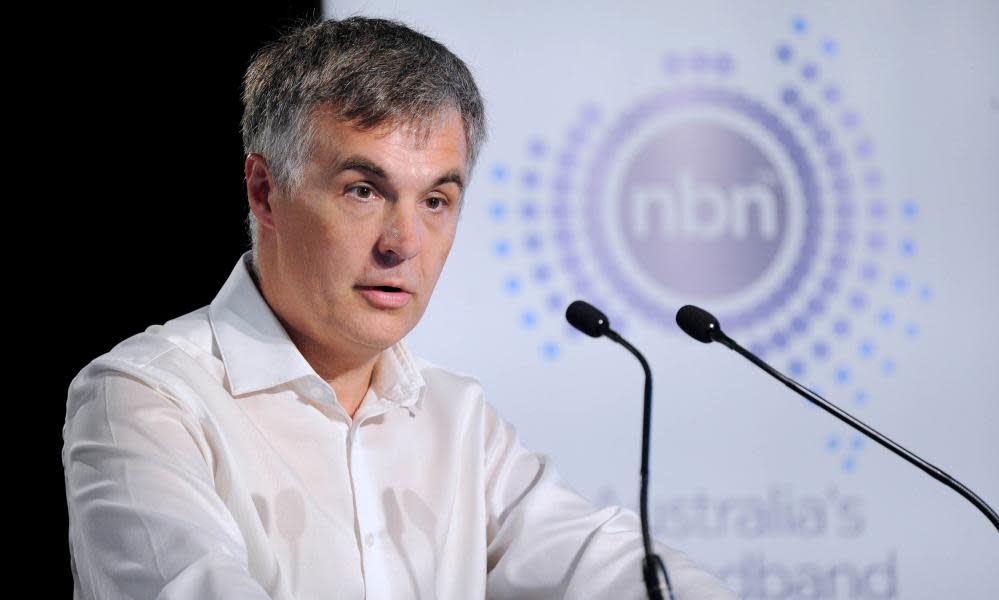Proposed NBN price hikes could double some internet bills within a decade, ACCC warns

Australians face steep price hikes under a proposed new pricing model for the national broadband network, with retailers warning it could lead to some of the highest internet access costs in the world.
The Australian Competition and Consumer Commission (ACCC) released a consultation paper on Monday detailing proposed changes to NBN Co’s special access undertaking, which sets out how the company charges retailers for user plans and bandwidth.
NBN Co has proposed getting rid of bandwidth, or capacity, fees for its high-speed plan but keeping them for low and mid-tier plans.
Related: Revealed: how a crafty Labor move on the NBN is being used to win over voters
Under the proposal, the cheapest wholesale plan would double in price over the next decade, and eventually cost as much as a plan with four times the download speed. Retailers say they would be forced to pass on the costs.
NBN Co’s forecasts suggested that the maximum allowable cost to retailers for the entry-level plan would double by 2033, and would go to $104 a month by 2040.
Telstra has said NBN Co’s proposed model would lead to even higher prices for broadband, and would drive more people to wireless broadband products.
“NBN’s wholesale prices are already the highest in the world among comparable countries and they’ll get worse with the proposed price increases,” a spokesperson said.
A spokesperson for TPG said the proposal was a “slap in the face for those who rely on affordable broadband to stay connected for work, study and play”.
“The only thing clear from NBN’s convoluted pricing model is that internet services are going to get more expensive for Australians in the future,” the spokesperson said.
“The NBN’s pricing proposal can be summed up as price hikes and no improvements.”
Optus’s vice president of regulatory and public affairs, Andrew Sheridan, said Optus was disappointed, and the proposal would hit everyone’s hip pocket.
“Retail providers like Optus will have no choice but to pass proposed cost increases onto our customers, knowing that many are already feeling the pain of rising household costs,” he said.
“The new government has an opportunity to refocus NBN Co’s priorities towards its core objective of ensuring all Australians have access to fast broadband, at affordable prices, and at least cost.”
NBN Co has proposed making the 25 megabits per second (Mbps) download speed plan the entry-level tier, and keep bandwidth or capacity charges for all plans below 100Mbps. Those plans would be bundled with a set bandwidth allowance, and retailers would be charged on top of that for how much they actually use rather than how much they think they need.
There would be an excess fee of $8 per Mbps of bandwidth a month, and the bundles would be reviewed every six months to determine how much more bandwidth should be included in the bundle as user demand continued to rise.
But it would do away with the bandwidth charge for users on 100Mbps or more, instead just charging a flat fee, which would be increased each financial year.
The ACCC warned in its consultation paper that the $8 fee was above the cost of making more bandwidth available to retailers, and it could lead to costs rising due to the bandwidth allocation not meeting expected demand. NBN Co had forecast an annual peak data demand growth of 13%, but only allowed for bundle allowance increases of around half this level.
The 100Mbps plan costs rise with the rate of CPI plus 3% in the first few years, and then CPI or 3% later on.
What it would mean in practice is that the cost of the lower speed plans would match the 100Mbps plan within a few years. This would be because the underlying plan rises at the same rate, plus the additional cost of bandwidth use on top of that as demand for data grows.
ACCC modelling suggests the cost for the 50Mbps plan would equal the 100Mbps plan by 2027, and the 25Mbps plan would reach the same price by 2034.
The pricing would, according to NBN Co’s modelling, push many users on to the 100Mbps plan, which the ACCC said was more than many households would need.
Modelling by the Bureau of Communications and Arts Research, put together as part of the consultation, argues the median household speed requirement by 2028 would be 29Mbps, and 99.9% of households would not need more than 78Mbps.
A new communications minister in the Albanese Labor government has yet to be sworn in.
NBN Co said it welcomed the paper and the opportunity to continue the pricing discussion with the ACCC and retailers.
An Accenture affordability report, put together by NBN Co last year, found Australia ranked sixth for affordable broadband in the OECD.
Related: ‘We were kind of terrified’: rural Telstra customers lose service for a week
The drive for the change, the ACCC said, was NBN Co had accumulated “significant losses” since the network construction began in 2009 – $38bn in real terms or $44.5bn in nominal terms.
NBN Co had also proposed a $12-per-month voice-only service for people who did not want a fixed line internet service, but need a phone line.
Consultation on the paper is open until 8 July, with the ACCC planning to release a draft decision on whether to accept the pricing changes in September 2022.
In Senate estimates just prior to the election, NBN Co’s chief executive Stephen Rue said the process to decide the final cost would take between six and nine months.

 Yahoo Movies
Yahoo Movies 
